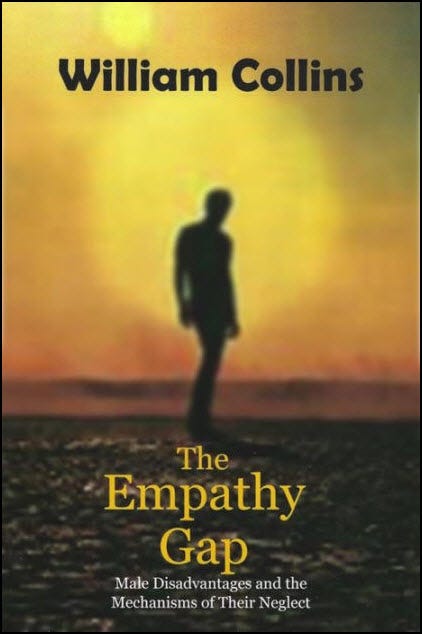A Letter to Washington Post Staff About their “Abused by the badge” Investigation – Part 2
An introduction to the "gender empathy gap" that disadvantages men and boys
Dear Messrs. /Mses. Contrera, Abelson, Harden, Godfrey, Jones, et al.,1
Earlier this week I emailed all of you to let you know about an open letter I published on my Substack site about the Post’s Abused by the badge investigation.
Although I commended your team for its fine work on both the investigation and the resulting article, I implicitly posed the question
“Why doesn't the Post perform similar studies about the abuse of men and boys?”
I then offered some suggestions for other investigations that the Post might undertake, including:
Abused by their Teachers: to examine the sexual assault and rape of boys by their female teachers
Abused by the Washington Post: Male Victims of Domestic Violence: to examine how the Post has neglected male victims of DV
Abused by Feminism: Marriage, Fathers and Families: to explore the impact of feminism’s oft-stated goal for the destruction of fathers and families
Abused by American Women: Sexual Assault and #MeToo: to examine the hypocrisy of #MeToo and false accusations of sexual assault
Abused by the Federal Government: Young Men and Title IX: to examine how the federal government has abused the civil rights of young men at U.S. colleges and universities
Due to the amount of material related to these suggested investigations, I decided to document my final suggestion in a separate letter; this is part 2 of my open letter to you. (Part 1 can be found here.)
Abused by Chivalry: The Gender Empathy Gap
In the past five decades, Washington Post columnists have written countless articles that woefully describe how women are oppressed, how hard their lives are, and how unfairly they’ve been treated by an “uncaring, sexist, patriarchy-controlled society”.
For example, in just the past few years, the Post has published the following articles:
In 2021 Janay Kingsberry wrote an article about a Gallup poll showing that U.S. women are dissatisfied with how they’re treated, ignoring that the poll only asked about the “treatment of women in society”, thus completely overlooking how men are treated. (See my letter to Kingsberry.)
In 2023 Donna St. George wrote an article about how teen girls are “engulfed in a growing wave of violence and trauma”, citing frightening statistics about girls’ suffering and victimization, but mostly ignoring the often greater suffering of boys (e.g. much higher rates of suicide) or that boys’ hardships are largely ignored by articles and columnists like Ms. St. George. (See my letter to her.)
This past April Karen Attiah wrote an article, The tragedy and promise of #BringBackOurGirls, marking the 10th anniversary of the horrible kidnapping of nearly 300 schoolgirls by Boko Haram terrorists, completely silent about an even worse atrocity that befell Nigerian boys only months before, when 60 boys were burned alive by the same terrorists. (See my letter to Attiah.)
The rampant publication of untold thousands of similar gender-biased articles is compelling evidence of something called the gender empathy gap.
Like most Americans, you all have likely never heard of it. This empathy gap is “… the striking and disturbing indifference of our culture to the suffering of men and boys in stark contrast to our evident concern for the suffering of girls and women.” [From a video clip of anti-feminist Janice Fiamengo talking about the empathy gap]
The empathy gap is why thousands of articles just like yours focus only on women, completely oblivious to men’s far greater suffering, despite easily obtainable facts:
Males:
live six years less than women
suffer 94% of workplace deaths
are 80% of the homeless
are 80% of deaths by suicide
are 76% of homicide victims
are more likely than women to be charged with crimes, receive 63% longer sentences on average, while women are twice as likely to avoid incarceration if convicted [from Estimating Gender Disparities in Federal Criminal Cases]
form the only group who, via the Forced Labour Convention of 1930, is still subject to a type of slavery (aka “military conscription” — the law exempts “able-bodied males between ages 18 and 45 from the ban on slavery and forced labor”)
finally, males are at least 50% of the victims of domestic violence (just ask Johnny Depp), yet are nearly 100% ineligible from receiving assistance from taxpayer-funded DV shelters. If you don’t believe that women perpetuate at least 50% of DV, please read this law review article (PDF), written by a woman.
Despite these well-documented male disadvantages, feminists have convinced many that men instead have “male privilege”. If you believe that men are privileged, please view this video.
But the gender empathy gap is even more insidious and widespread than just these undeniable facts, and this gap has always been, quite literally, right in front of us. As the late men’s rights activist Marc Angelucci once wrote,
“We simply don’t care much about men. In fact, the devaluation of male lives is so entrenched in our psyches and endemic to our system that we refuse to see it — even when it’s smack in our face.” [from Gender Bias Toward Males Frequently Gets Overlooked Daily Bruin Online, 2/20/01]
An example that proves Mr. Angelucci’s point is the way that mainstream news sources report on the injury or death of men and boys versus the way that they report on that of women and girls. When men are injured or killed, they are often referred to as “workers”, “soldiers” or even “people”. When women are injured or killed, they are usually referred to as “female” or “women”, and their gender becomes central to the story.
A glaring example of this gender gap in the media is the aforementioned #BringBackOurGirls, that received intense, international attention, yet there was scarcely a trickle of media attention when Boko Haram killed hundreds of boys — many burned alive — months before the girls’ kidnapping. Please view this video about the shameful neglect of these boys’ deaths — because they were male.
Recommended sources for your investigation:
The book The Empathy Gap: Male Disadvantages and the Mechanisms of Their Neglect provides a comprehensive analysis, with supporting evidence that proves how “…men and boys are extensively disadvantaged across many areas of life, including in education, healthcare, genital integrity, criminal justice, domestic abuse, working hours, taxation, pensions, paternity, homelessness, suicide, sexual offences [British spelling], and access to their own children after parental separation.”2
The book The Privileged Sex, which makes a solid, convincing case that contrary to the feminist-dictated dogma that women are “oppressed”, they are instead in many, many ways privileged:
“Judged by almost any criterion, women are, and always have been, the privileged sex. … As children they are treated more gently and receive more protection. As students they have long been excused, or excused themselves, from whatever subjects were considered hardest. As adults they are under less pressure to compete and perform. As workers they do rather less than half of humanity’s productive labor. As economic beings they are often in the enviable position of being able to consume without having to produce. As criminals and litigants they are treated much more leniently both by the law and the courts. As members of society they are both freed from the duty to participate in the most terrible of all human activities, war, and enjoy better protection against it.”
For examples of the gender empathy gap at the Post read some of my many letters to Post columnists where I introduce the gap to them.
In closing, allow me to provide a quote by Supreme Court justice and three times-wounded Civil War veteran Oliver Wendell Holmes that I believe succinctly and authoritatively proves the existence of the gender empathy gap:
“All societies rest on the death of men”.
If you really think about it, he was right, don’t you think?
Sincerely,
Stephen Bond
Publisher of "Letters to The Washington Post" Substack
This letter is specifically addressed to the main credited authors of “Abused by the Badge”, but implicitly includes many more researchers and writers in a team from the Post and Bowling Green State and American universities. All are listed under the “About our team” section.
There’s also a companion website, The Illustrated Empathy Gap: challenging public incredulity on the disadvantages faced by men and boys that continuously adds more information that undeniably proves the existence of the gender empathy gap that works against men





